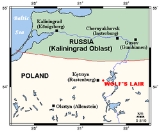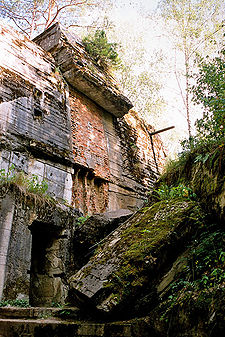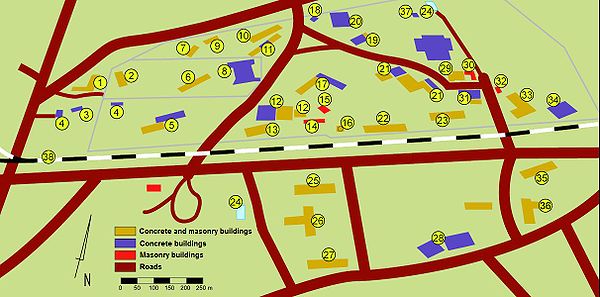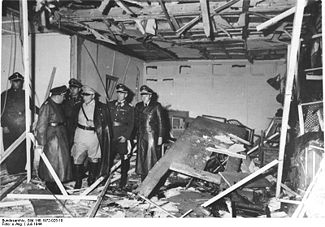
Wolfsschanze
Encyclopedia


Adolf Hitler
Adolf Hitler was an Austrian-born German politician and the leader of the National Socialist German Workers Party , commonly referred to as the Nazi Party). He was Chancellor of Germany from 1933 to 1945, and head of state from 1934 to 1945...
's first World War II
World War II
World War II, or the Second World War , was a global conflict lasting from 1939 to 1945, involving most of the world's nations—including all of the great powers—eventually forming two opposing military alliances: the Allies and the Axis...
Eastern Front
Eastern Front (World War II)
The Eastern Front of World War II was a theatre of World War II between the European Axis powers and co-belligerent Finland against the Soviet Union, Poland, and some other Allies which encompassed Northern, Southern and Eastern Europe from 22 June 1941 to 9 May 1945...
military headquarters
Headquarters
Headquarters denotes the location where most, if not all, of the important functions of an organization are coordinated. In the United States, the corporate headquarters represents the entity at the center or the top of a corporation taking full responsibility managing all business activities...
, one of several Führerhauptquartier (Führer Headquarters
Führer Headquarters
The Führer Headquarters , abbreviated FHQ, is a common name for a number of official headquarters used by the Nazi leader Adolf Hitler and various German commanders and officials throughout Europe during World War II...
) or FHQs located in various parts of Europe. The complex, which was built for Operation Barbarossa
Operation Barbarossa
Operation Barbarossa was the code name for Germany's invasion of the Soviet Union during World War II that began on 22 June 1941. Over 4.5 million troops of the Axis powers invaded the USSR along a front., the largest invasion in the history of warfare...
, the 1941 German invasion of the Soviet Union
Soviet Union
The Soviet Union , officially the Union of Soviet Socialist Republics , was a constitutionally socialist state that existed in Eurasia between 1922 and 1991....
, was located in the Masuria
Masuria
Masuria is an area in northeastern Poland famous for its 2,000 lakes. Geographically, Masuria is part of two adjacent lakeland districts, the Masurian Lake District and the Iława Lake District...
n woods, about 8 kilometres (5 mi) from the small East Prussia
East Prussia
East Prussia is the main part of the region of Prussia along the southeastern Baltic Coast from the 13th century to the end of World War II in May 1945. From 1772–1829 and 1878–1945, the Province of East Prussia was part of the German state of Prussia. The capital city was Königsberg.East Prussia...
n town of Rastenburg
Ketrzyn
Kętrzyn , is a town in northeastern Poland with 28,351 inhabitants . Situated in the Warmian-Masurian Voivodeship , Kętrzyn was previously in Olsztyn Voivodeship . It is the capital of Kętrzyn County...
, now Kętrzyn
Ketrzyn
Kętrzyn , is a town in northeastern Poland with 28,351 inhabitants . Situated in the Warmian-Masurian Voivodeship , Kętrzyn was previously in Olsztyn Voivodeship . It is the capital of Kętrzyn County...
in Poland
Poland
Poland , officially the Republic of Poland , is a country in Central Europe bordered by Germany to the west; the Czech Republic and Slovakia to the south; Ukraine, Belarus and Lithuania to the east; and the Baltic Sea and Kaliningrad Oblast, a Russian exclave, to the north...
.
The original bunker system was constructed by Organisation Todt
Organisation Todt
The Todt Organisation, was a Third Reich civil and military engineering group in Germany named after its founder, Fritz Todt, an engineer and senior Nazi figure...
, but the later planned enlargement was never finished; the expansion work was stopped only a few days before the Russian advance to Angerburg (now Węgorzewo
Wegorzewo
Węgorzewo is a tourist town in the Warmian-Masurian Voivodeship, Poland, not far from the border with Russia's Kaliningrad Oblast. It is the seat of Węgorzewo County. Lake Mamry is close to the town.-Etymology:...
), only 15 kilometres (9.3 mi) away.
Hitler first arrived at the Wolf's Lair late on the night of 23 June 1941, and departed for the last time on 20 November 1944. Overall, he spent over 800 days there during that 3½-year period.
The complex was blown up and abandoned on 25 January 1945, but many of the bunkers were so thick that their damaged walls and ceilings remain. The remains are located in Poland at the hamlet of Gierłoż near Kętrzyn.
Overview
The decision to build the Wolf's Lair was made in the autumn of 1940. Built in the middle of a protecting forest, and located far from major roads, the complex occupied more than 6.5 square kilometre and consisted of three separate security zones, the most important of which was Sperrkreis 1 (Security Zone 1), in which was located the Führer Bunker and concrete shelters of members of the inner circle such as Hermann GöringHermann Göring
Hermann Wilhelm Göring, was a German politician, military leader, and a leading member of the Nazi Party. He was a veteran of World War I as an ace fighter pilot, and a recipient of the coveted Pour le Mérite, also known as "The Blue Max"...
, Martin Bormann
Martin Bormann
Martin Ludwig Bormann was a prominent Nazi official. He became head of the Party Chancellery and private secretary to Adolf Hitler...
, OKW chief Wilhelm Keitel
Wilhelm Keitel
Wilhelm Bodewin Gustav Keitel was a German field marshal . As head of the Oberkommando der Wehrmacht and de facto war minister, he was one of Germany's most senior military leaders during World War II...
and "chief of operations" OKW Alfred Jodl
Alfred Jodl
Alfred Josef Ferdinand Jodl was a German military commander, attaining the position of Chief of the Operations Staff of the Armed Forces High Command during World War II, acting as deputy to Wilhelm Keitel...
. There were a total of ten bunkers in this area, all camouflaged and protected by 2 metres (6.6 ft) of steel-reinforced concrete. Hitler's was on the northern end, with all its windows facing north to avoid direct sunlight. Both Hitler's and Keitel's bunkers had rooms in which military conferences could be held.
Sperrkreis 2 (Security Zone 2) included military barracks and housing for several important Reich Ministers like Albert Speer
Albert Speer
Albert Speer, born Berthold Konrad Hermann Albert Speer, was a German architect who was, for a part of World War II, Minister of Armaments and War Production for the Third Reich. Speer was Adolf Hitler's chief architect before assuming ministerial office...
, Joachim von Ribbentrop
Joachim von Ribbentrop
Ulrich Friedrich Wilhelm Joachim von Ribbentrop was Foreign Minister of Germany from 1938 until 1945. He was later hanged for war crimes after the Nuremberg Trials.-Early life:...
and Fritz Todt
Fritz Todt
Fritz Todt was a German engineer and senior Nazi figure, the founder of Organisation Todt. He died in a plane crash during World War II.- Life :Todt was born in Pforzheim to a father who owned a small factory...
as well as Hitler's escort battalion, the Führer Begleit Brigade
Führer Begleit Brigade
The Führerbegleitbrigade was a German armoured brigade and later armoured division , in World War II...
. Sperrkreis 3 (Security Zone 3) made up the outer security area of the compound, complete with land mines, special security troops and guard houses.
Close by was a facility for the Wehrmacht
Wehrmacht
The Wehrmacht – from , to defend and , the might/power) were the unified armed forces of Nazi Germany from 1935 to 1945. It consisted of the Heer , the Kriegsmarine and the Luftwaffe .-Origin and use of the term:...
Operations Staff, and army headquarters was located several kilometres to the northeast of the FHQ complex. All these installations were served by a nearby airfield and train lines.
About two thousand people lived and worked at the Wolf's Lair at its peak, among them twenty women.

Name origin
A self-adopted nickname of Hitler's was "Wolf", likely suggested by the derivation of his given name Adolf from the Old High GermanOld High German
The term Old High German refers to the earliest stage of the German language and it conventionally covers the period from around 500 to 1050. Coherent written texts do not appear until the second half of the 8th century, and some treat the period before 750 as 'prehistoric' and date the start of...
adal and wolf ("noble wolf"). Hitler began using the nickname in the early 1930s, and was so addressed only by those in his intimate circle. The nickname is reflected in the names of his various headquarters scattered throughout continental Europe
Continental Europe
Continental Europe, also referred to as mainland Europe or simply the Continent, is the continent of Europe, explicitly excluding European islands....
, which also include Wolfsschlucht in Belgium
Belgium
Belgium , officially the Kingdom of Belgium, is a federal state in Western Europe. It is a founding member of the European Union and hosts the EU's headquarters, and those of several other major international organisations such as NATO.Belgium is also a member of, or affiliated to, many...
and Wehrwolf
Wehrwolf
Führerhauptquartier Werwolf was the codename used for one of Adolf Hitler's World War II Eastern Front military headquarters located in a pine forest about north of Vinnytsia in Ukraine that was used between 1942 and 1943...
in Ukraine
Ukraine
Ukraine is a country in Eastern Europe. It has an area of 603,628 km², making it the second largest contiguous country on the European continent, after Russia...
.
Although the standard name in English for Wolfsschanze is "Wolf's Lair", the German name does not actually mean this. Schanze is a term from military engineering and is best translated as "fortification
Fortification
Fortifications are military constructions and buildings designed for defence in warfare and military bases. Humans have constructed defensive works for many thousands of years, in a variety of increasingly complex designs...
" or "sconce
Sconce
Sconce may refer to any of the following:* Sconce , a military fortification* Sconce * Sconcing, imposing a penalty in the form of drink* SCoNCe, , University of California, Irvine...
".
Daily routine
When Hitler was in residence, he would begin the day by taking a walk alone with his dog around 9 or 10 a.m., and at 10:30 a.m. would look at the mail which had been delivered by air or courier train, but the daily routine centred on a noon situation briefing held in Keitel's and Jodl's bunker, which frequently ran as long as two hours. This was followed by a long lunch at 2 p.m., where Hitler would invariably sit in the same place, as he did at every meal, between Jodl and Otto DietrichOtto Dietrich
Dr. Otto Dietrich was an SS-Obergruppenführer, the Third Reich's Press Chief, and a confidant of Adolf Hitler.-Biography:...
, the Nazi Press Chief, while opposite him sat Keitel, Hitler's secretary, Martin Bormann
Martin Bormann
Martin Ludwig Bormann was a prominent Nazi official. He became head of the Party Chancellery and private secretary to Adolf Hitler...
and General Karl Heinrich Bodenschatz, Göring's adjutant.
After lunch, Hitler would deal with non-military matters for the remainder of the afternoon. Coffee was served around 5 p.m., followed by a second military briefing by Jodl at 6 p.m. Dinner, which could last as long as two hours, began at 7:30 p.m., after which films were shown. The late nights were taken up by Hitler's monologues to his entourage, including two of his female secretaries, who had accompanied Hitler to the Wolf's Lair. Occasionally Hitler and his entourage listened to gramophone record
Gramophone record
A gramophone record, commonly known as a phonograph record , vinyl record , or colloquially, a record, is an analog sound storage medium consisting of a flat disc with an inscribed, modulated spiral groove...
s of Beethoven symphonies, selections from Wagner or other operas, or German lieder.
Security and camouflage
The ReichssicherheitsdienstReichssicherheitsdienst
The Reichssicherheitsdienst was an SS security force of Nazi Germany. Originally the personal bodyguards of Adolf Hitler, it later provided men for the protection of other high-ranking leaders of the Nazi regime...
(Reich Security Service) or RSD had overall responsibility for Hitler's personal security, but external protection of the complex was provided by the Führer Escort Battalion
Führer Begleit Brigade
The Führerbegleitbrigade was a German armoured brigade and later armoured division , in World War II...
(FBB), which, despite its name, had reached regiment strength by July 1944. The Battalion was heavily equipped, with tanks, anti-aircraft guns and other heavy weapons. Aircraft could be detected about 100 kilometres (62.1 mi) from the complex. Additional troops were stationed about 75 kilometres (46.6 mi) away.
The buildings in the complex were camouflaged by having bushes, grass and artificial trees planted on the flat roofs, and by the use of camouflage netting between the building and the surrounding forest. From the air, the installation looked like dense forest.
Assassination attempt

July 20 Plot
On 20 July 1944, an attempt was made to assassinate Adolf Hitler, Führer of the Third Reich, inside his Wolf's Lair field headquarters near Rastenburg, East Prussia. The plot was the culmination of the efforts of several groups in the German Resistance to overthrow the Nazi-led German government...
to kill Hitler. During the period of reconstruction of the Führer Bunker in the summer of 1944, the daily strategy meetings were moved to the little building known as the Lager barrack, where staff officer Claus von Stauffenberg
Claus Schenk Graf von Stauffenberg
Claus Philipp Maria Justinian Schenk Graf von Stauffenberg commonly referred to as Claus Schenk Graf von Stauffenberg was a German army officer and Catholic aristocrat who was one of the leading members of the failed 20 July plot of 1944 to assassinate Adolf Hitler and remove the Nazi Party from...
carried a bomb hidden in a briefcase into the meeting room and placed it just a few feet away from Hitler. At 12:43 p.m. the bomb devastated the interior of the building but left Hitler only slightly injured. However, four others died from their wounds a few days later. The force of the blast was diminished because, due to a war injury to his hand, Stauffenberg was unable to arm both bombs in the briefcase; and a staff officer unknowingly moved the briefcase on the opposite side of a thick wooden table leg from where von Stauffenberg had placed it, probably saving Hitler's life. It is believed that had the bomb exploded in the massive concrete Führer Bunker as originally intended, everyone in the structure including Hitler would have been killed.
Plotters' escape
Just moments before the blast, the would-be assassin and his adjutant, LieutenantLieutenant
A lieutenant is a junior commissioned officer in many nations' armed forces. Typically, the rank of lieutenant in naval usage, while still a junior officer rank, is senior to the army rank...
Werner von Haeften
Werner von Haeften
- See also :* German Resistance* List of members of the July 20 plot...
rapidly made their way from the conference barrack toward the first guard post just outside Sperrkreis 1. After a short delay they were allowed to pass and proceeded along the southern exit road toward Rastenburg airport. By the time they reached the guard house at the perimeter of Sperrkreis 2, the alarm had been sounded. According to the official Gestapo report, "at first the guard refused passage until von Stauffenberg persuaded him to contact the adjutant to the compound commander who then finally authorized clearance". It was between here and the final checkpoint of Sperrkreis 3 that von Haeften tossed a second briefcase from the car containing a second bomb which was also intended to explode in the conference barrack. It is believed that had this bomb also been placed with the other, everyone inside would have been killed. Checkpoint three, the final barrier located at the outer reaches of the Wolfsschanze, was expected to prove impenetrable, but the two men were simply waved through to the Rastenburg airport.
Thirty minutes after the bomb blast the two men were airborne and on their way back to Berlin and Army general headquarters. It was in this building, called the Bendlerblock
Bendlerblock
The Bendlerblock is a building in Berlin, located on the Stauffenbergstraße , south of the Tiergarten. The building was erected between 1911 and 1914 for the Imperial German Navy Offices. During the Weimar Republic it served as the seat of the Reichswehr command and the Ministry of Defence...
, that "Operation Valkyrie
Operation Valkyrie
Operation Valkyrie was an emergency continuity of government operations plan developed in Nazi Germany for the Territorial Reserve Army of Germany to execute and implement in case of a general breakdown in civil order of the nation...
", a covert plan to react to the breakdown in civil order of the nation and suppress any revolt was transformed into the secret plot to assassinate the Führer
Führer
Führer , alternatively spelled Fuehrer in both English and German when the umlaut is not available, is a German title meaning leader or guide now most associated with Adolf Hitler, who modelled it on Benito Mussolini's title il Duce, as well as with Georg von Schönerer, whose followers also...
of the German Reich. However, when it was discovered that Hitler was still alive, the plan was doomed and along with it von Stauffenberg, his adjutant Werner von Haeften
Werner von Haeften
- See also :* German Resistance* List of members of the July 20 plot...
and co-conspirators General Friedrich Olbricht
Friedrich Olbricht
General Friedrich Olbricht was a German general and one of the plotters involved in the attempt to assassinate Adolf Hitler at the Wolfsschanze in East Prussia on 20 July 1944.-Early life:...
and his chief of staff Colonel Albrecht Mertz von Quirnheim
Albrecht Mertz von Quirnheim
Albrecht Ritter Mertz von Quirnheim was a German officer and a resistance fighter in Nazi Germany involved in the 20 July plot against Adolf Hitler.-Biography:...
, who were arrested and executed in the courtyard of the Bendlerblock on the evening of July 20, 1944.
Aftermath
On 20 August 1944, Hitler personally presented the survivors of the bomb blast with a special award: The Wound BadgeWound Badge
Wound Badge was a German military award for wounded or frost-bitten soldiers of Imperial German Army in World War I, the Reichswehr between the wars, and the Wehrmacht, SS and the auxiliary service organizations during the Second World War. After March 1943, due to the increasing number of Allied...
of 20 July 1944, along with an ornate award document. Hitler had believed that his survival was "divine providence", and had the special wound badge made to reflect this belief, although he did not award one to himself. Next-of-kin of those killed in the bomb blast were given this wound badge in Gold.
Demolition

Red Army
The Workers' and Peasants' Red Army started out as the Soviet Union's revolutionary communist combat groups during the Russian Civil War of 1918-1922. It grew into the national army of the Soviet Union. By the 1930s the Red Army was among the largest armies in history.The "Red Army" name refers to...
reached the nearby border of East Prussia in October 1944. Hitler departed on 20 November and two days later the order was given to destroy the complex. The actual demolition did not take place until the night of 24–25 January 1945. Many tons of explosives were required to do the job; one bunker required an estimated 8 tons of TNT. The Red Army took the site without a shot two days later, on 27 January, the same day Auschwitz was liberated further south. It took until 1955 to clear over 54,000 landmines which surrounded the installation.

